Golden Triangle Tour

Visit the most popular historical and cultural sites in three most visited, fascinating cities in 7 days / 6 hotel overnights. Each of these three most historic cities in northern India has some of the finest and most famous UNESCO World Heritage Sites and other amazing monuments. Prices include 3-star or 5-star hotels with breakfast on double/twin occupancy basis (supplement for single hotel room occupancy is extra), air-conditioned car with driver, English speaking guide in all monuments, entrances to monuments, Rickshaw ride in Chandni Chowk Bazaar in Delhi, Elephant ride in Amber Fort & much more.
DAY 01: ARRIVE DELHI
Upon arrival, assistance and transfer to hotel
Overnight at hotel
Day 2 DELHI:

After breakfast sightseeing of Qutub Minar: its construction was initiated by Qutubudin-Aibak in 1198 CE upon becoming the first Sultan of Delhi.
Qubub Uddin Aibak was born in Turkestan of ethnic Mamluk descent. This was a region where youth went out to neighboring countries and joined their armies as mercenaries. Often they were enslaved when the army they were fighting with lost. Qutubuddin was sold to the Qazi (Islamic judge) of Nishapur in Persia. There he became favorite of his master because of his skills of horseriding and archery among other warrior abilities. Qazi’s sons were jealous and they sold him after the Qazi’s death. Finally he ended up as slave of Sultan Muhammad of Ghur province of Afghanistan. He led Sultan of Ghur’s army in the 1st and 2nd battle of Tarain and was appointed Governor of Lalkot, the capital of the last Hindu Chauhan dynasty kingdom. When Muhammad of Ghur was assassinated, Qutubuddin bin Aibak declared himself sovereign monarch and started the construction of Qutub Jami Mosque (a.k.a. Quwwat ul Islam Mosque) and Qutub Minar. The construction of minaret did not complete in his lifetime and many later Islamic rulers of various successive dynasties left their mark on this monument, which is now 5 stories high and 73 meters or 240 feet tall. The mosque was constructed using architectural elements of 27 Hindu and Jain temples that were demolished to build it. Much of the decorative pillars and facades of walls in the mosque were used without alteration in the new mosque, only the Arabic verses from the Quran were added new, sculpted by Hindu artisans who did not know the Arabic language and curved the endings of letters as they did with Sanskrit language carvings. Qutub Minar is a UNESCO World Heritage Site.
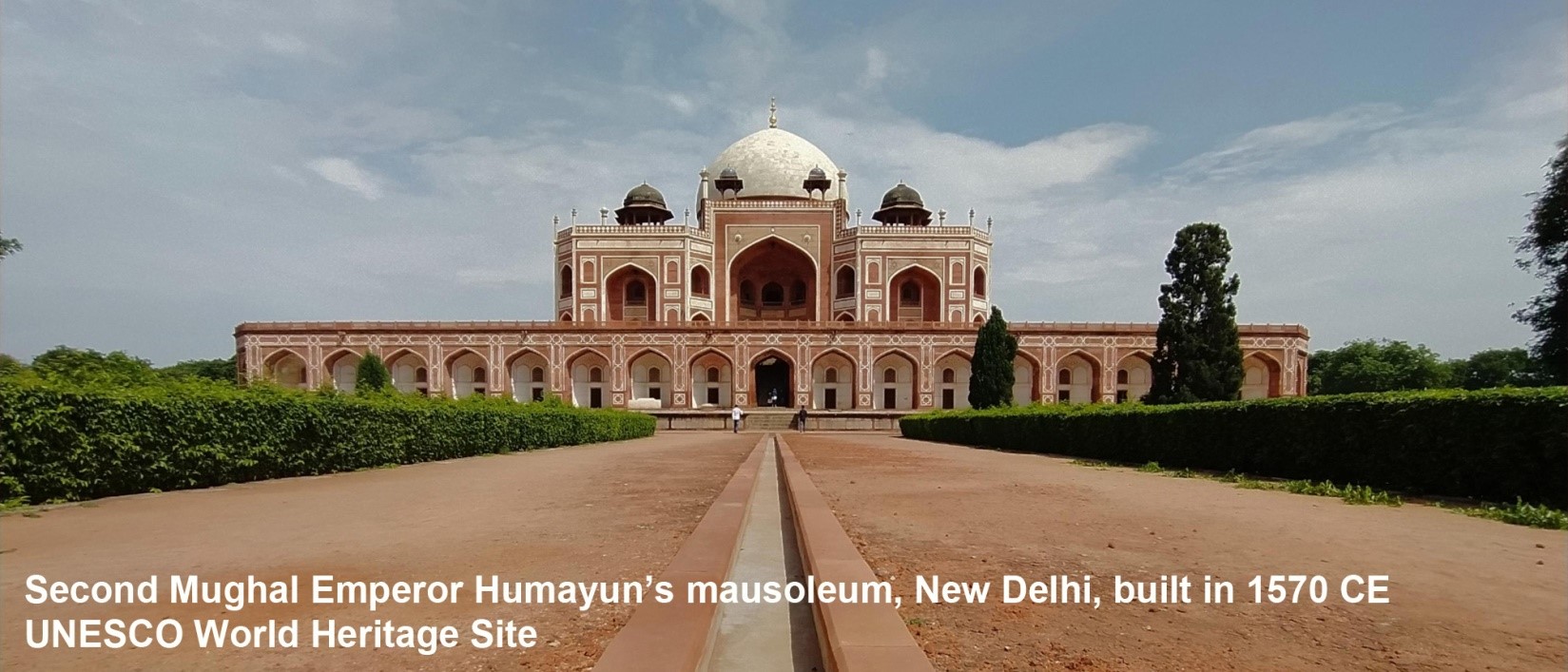
Later sightseeing of the Second Mughal Emperor Humayun's Tomb - its architecture may have influenced the construction of the Taj Mahal in Agra. Emperor Humayun died just six months after winning the throne of Delhi in 1556 CE. His widow, Hamida Bano Begum (a.k.a. Haji Begum) supervised its construction under Mughal Emperor Akbar’s rule. Having recently returned from Persia and its architect, Mirak Mirza Ghiyath, being a Persian, the monuments has elements of Persian and Hindu architecture blended in it. Many later Mughal rulers are also buried in this mausoleum. Humayun’s Tomb is a UNESCO World Heritage Site.
Proceed further for sightseeing of India Gate (the war memorial), Parliament House and Presidents House (from outside) and for lunch at Gulati’s Restaurant in Khan Market nearby. The British decided in 1911 to move their capital from Calcutta (now Kolkata) to Delhi. Edwin Landseer Lutyens and his friend Herbert Baker were chosen for designing various buildings in the new capital. In 1914 the First World War started and continued until 1918. During this period the new capital’s construction was halted. Finally after its construction completed, the British capital was moved to New Delhi in 1931. India Gate was originally a monument to honor the fallen Indian soldiers in World War I, but now honors Indian soldiers all subsequent wars.
In the afternoon stop by the Red Fort for photography from outside - the massive sandstone fort built by Shah Jahan on the banks of river Yamuna. The fifth Mughal Emperor Shahjahan moved his capital from Agra to Delhi in 1636 and started the construction of the walled “Shahjahanabad” city with 14 gates. The most important gates, Mori, Lahori, Ajmeri, Turkman, Kashmiri and Delhi Gates still exist along with remnants of the wall. Within the city there were many monuments constructed but the most ambitious project was the Red Fort – according to a horoscope done to determine the auspicious time for starting its construction, the work on building the Red Fort started on May 12, 1639. In the Emperor’s Balcony in Diwan-i-Am or the Hall of Public Audience, there are a set of marble panels that were made in Pietra Dure art by the Florentine jeweler, Austin de Bordeaux. The most famous of these is the one depicting Orpheus playing the flute. There are many other palaces in the fort that were decorated with inlay of semi-precious stones in marble. Red Fort is a UNESCO World Heritage Site.
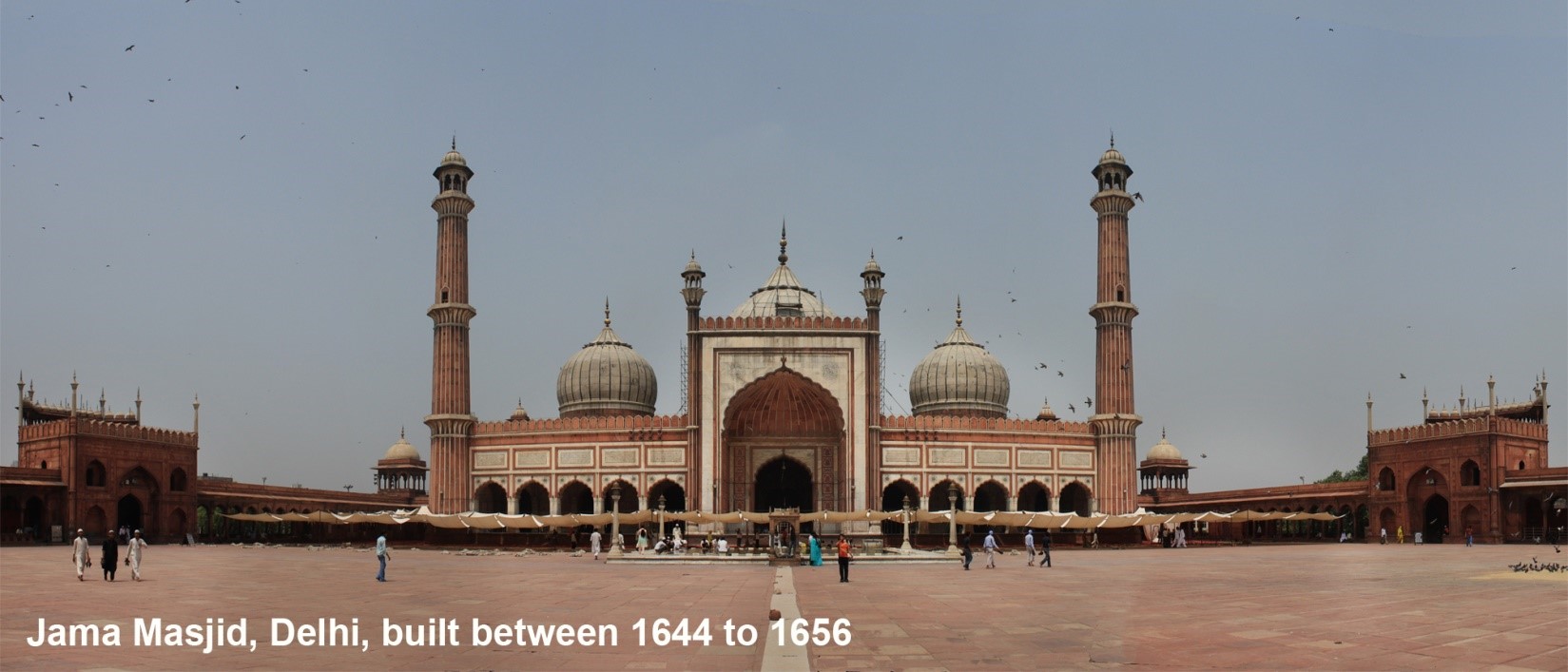
Jama Masjid - is the largest mosque in India and stands across the road from the Red Fort, built by Mughal Emperor Shahjahan 1650-56 CE. It was originally called "Masjid-i-Jahannuma" or world reflecting mosque. Its construction was supervised by Vazir Saadula Khan and its chief architect was Ustad Khalil. About 25,000 people can pray here at a time. Overnight stay in hotel in New Delhi.
Day 3 // DELHI - AGRA (165 Kilometers or 103 miles in 2 hours):
After breakfast transfer to Agra on the Yamuna Expressway and on arriving stop at the Tomb of Itmad-ud-Daulah. This is the mausoleum built under supervision of Empress Nurjahan for her parents, Mirza Ghiaz Beg and Begum Asmat in 1628 CE almost 7 years after her father's death. Mirza Ghiaz Beg received the title of Itmad-ud-Daulah or ‘Lord of Treasure of the Empire’ from Emperor Jahangir. Upon arrival check in to the hotel. Lunch in Pinch of Spice Restaurant on Fatehabad Road.

In the afternoon sightseeing of Agra Fort. Emperor Akbar moved his capital to Agra from Delhi in 1558 but the construction of the Agra Fort started in 1565. It was built on the ruins of an earlier fort named Badalgarh. The first Mughal Emperor Babur had occupied this fort after his victory in the battle of Panipat in 1526 CE. His son, second Mughal Emperor Humayun was crowned in the old fort of Badalgarh in 1530. With about 4000 laborers and craftsmen toiling for 8 years the fort's construction was completed in 1573. The entire fort was built with narrow flat brick masonry work and laminated with red sandstone from the stone quarry at Sikri village west of Agra. According the Emperor Akbar's official biography written by his trusted friend, Abul Fazl, there were about 5000 buildings in the fort. Some of these buildings were demolished to make way for white marble palaces of Emperor Shahjahan, facing the Yamuna River, on the eastern side of the fort. Most of the buildings in western side were converted in to soldier’s barracks by the British East India Company. The western part of the fort is still occupied by Indian military. Emperor Akbar's style was greatly influenced by the architecture of the states of Gujarat and Bengal. It is also very unique because it reflects Emperor Akbar's tolerant religious philosophy. The best of example of his architecture is visible in the palace popularly called Jahangiri Mahal. In 1666 the great Maratha warrior, Shivaji met with Emperor Aurangzeb but the Mughal Emperor broke his promise and arrested him. He managed to escape in a spectacular manner by hiding in fruit baskets for distribution to poor. The Jat and Maratha ruler occupied Agra Fort in later years. Finally in 1803 the British East India Company captured it and demolished most of its monuments, only about 30 monuments have survived in the south-eastern side of the fort. In 1983 the Agra Fort was declared a UNESCO World Heritage Monument.
On the way to hotel wonder at the largest collection of Zerdozi Embroidery Art in India. This embossed embroidery art is attributed to the Mughal Empress Nurjahan. It uses silver, gold and colored silk thread embroidery on silk and velvet background and is one of the unique arts originating in Mughal period. Overnight stay in hotel in Agra.
Day 4 // AGRA:
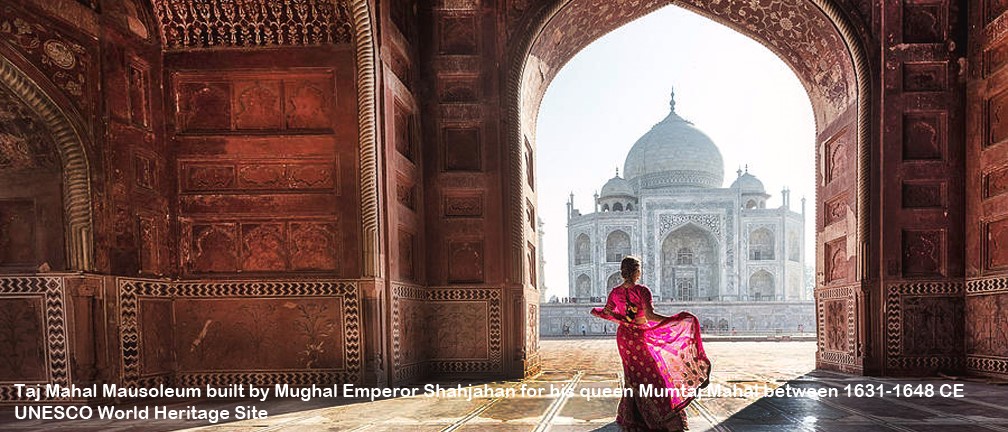
Wonder at the world famous Taj Mahal in the glow of morning sunlight.
Ample time in the vast complex for photographing and viewing the intricate Pietra Dure (inlay of semi-precious stones in marble art work, used in the exterior and interior of the monument.
Prince Khurram (later Emperor Shahjahan) and his father Prince Salim met their favorite future queens in a mock market called Meena Bazaar to celebrate the Persian new year festival of Nowroz in Agra Fort. Prince Salim wanted to marry Mehr un Nissa Begum, the daughter of Mirza Ghiaz Beg but Emperor Akbar did not want Shiya influence in the royal family so he asked Mirza Ghiaz Beg to marry his daughter to an Afghan commander and had him posted in Bihar. Prince Khurram was third eldest and not initially in direct line of succession. He was betrothed to Arjumand Bano Begum on April 5, 1607 but Prince Salim delayed his marriage. After death of Emperor Akbar, Prince Salim ascended the throne with the title of Emperor Jahangir and it was only in May 1610 that Mehr un Nissa, the widow of the Afghan commander finally agreed to marry him. He honored her with the title of Nurjahan (light of the world) after his marriage. One year later on May 10, 1612, Prince Khurram was finally allowed to marry his beloved Arjumand Bano Begum, who was the niece of Mehr un Nissa (her brother’s daughter and granddaughter of Mirza Ghiaz Beg). She received the title of Begum Mumtaj Mahal after her marriage with the Mughal prince. Begum Mumtaj Mahal was 19 years when they married. She was his constant companion and most trusted advisor. During their 19 years of marriage she gave birth to 14 children of which only 3 daughters and 4 sons survived. The youngest son, Aurangzeb fought a war of succession against his elder brothers. One after the other he won against all of them, had all the brothers killed and then put his father, Emperor Shahjahan, under arrest in his own palaces in Agra Fort. Queen Mumtaj Mahal died on June 17, 1631 while delivering her 14th child, a daughter, Gauhar Ara Begum, who survived and lived in Shahjahanabad to a ripe age of 75 years.
The site of the Taj Mahal mausoleum was a palace of the Maharaja of Amber, Mirza Raja Jai Singh. The Emperor asked him to give the palace back to him and gave him other properties in lieu. The queen was temporarily buried in Burhanpur where she died in an army encampment. The body was transferred to Agra and again temporarily buried in the northwest section of the garden of Taj Mahal where a red sandstone enclosure still marks the site of her temporary burial. The Taj Mahal mausoleum was completed in 1648 according to an inscription on its main gate.
The tomb was built exclusively for Queen Mumtaj Mahal, so her grave stone is in the center of the grave chamber. Emperor Shahjahan died on January 16, 1666 in Mussamam Burj Palace in Agra Fort. He was buried by the queen’s side and his grave stone is the only architectural feature in this mausoleum that is not symmetrical. Taj Mahal, is a UNESCO World Heritage Site.
After breakfast enjoy a demonstration of the art of Pietra Dure (inlay of semi-precious stones on marble surface) at Agra's oldest emporium where the not for sale section has some artifacts with inlay work much finer than the most intricate art work in the Taj Mahal itself and perhaps the world's best.
Subsequently visit Sikandara, the tomb of Emperor Akbar. Emperor Akbar started the construction of his mausoleum in his own lifetime in 1604. The emperor's friend, Abul Fazl, describes it in Akbarnama, the official and historical chronicle of Emperor Akbar's rule variously as Behistan and Behistabad or the abode in paradise. The construction continued for a very long time even after Emperor Akbar's demise. Emperor Jahangir was displeased with the slow construction and personally intervened to expedite it. Between 1612 and 1614, with the addition of its main gate that is more impressive than the simple mausoleum, the construction finally completed. The motifs and decoration on the main gate suggest a Persian influence and Empress Nur Jahan may have had a hand in its architecture.
After lunch at Pinch of Spice Restaurant in Sanjay Market in north Agra, drive to the Dayalbagh Temple which is actually a memorial of the first Guru (Teacher) of the Dayalbagh religious organization. Sir Shiv Dayal Sahab established this group in 1861. Its basic tenets are unity of God and its philosophy blends elements of Hinduism, Buddhism, Jainism, Sikhism and Islam. The construction of Dayalbagh Temple started in 1905 and was finally completed in 2018. It is now open to public. It has some of the finest sculptural elements in white and colored marble as well as very special Pietra Dure art work. After sightseeing return to hotel. Rest of afternoon is free to relax. Overnight stay in hotel in Agra.

Day 5 // AGRA - JAIPUR (232 Kilometers or 144 miles in 5 hours):
After breakfast drive one hour to Fatehpur Sikri for sightseeing of Mughal Emperor Akbar’s deserted capital and the tomb of Sufi saint Sheikh Salim Chistie in the courtyard of the grand mosque.
Emperor Akbar did not have a male heir to his throne for a long time. He came to the Sikri village to seek the blessings of the Sufi saint, Sheikh Salim Chistie, who prophesied that Emperor Akbar would have three sons. The emperor moved with his Hindu queen, Jodha Bai, to Sikri village to live with the saint and started building an alternative capital at the site which was earlier a query for red sandstone. The entire capital was built with red sandstone from the ridge on which it is located. The first born son was named Salim after the Sufi saint. The second was named Murad or the longed one. The third son was named Daniel, probably influenced by the Jesuit priests from Goa who were invited by the Emperor to teach him about Christianity. Emperor Akbar developed the philosophy of “Sulah Qul” – living in harmony with all religions. Later he developed his own religion, Din-i-Ilahi or faith of God. His dear friend and official biographer, Abul Fazl, was among the first to convert to the new religion which he described in “Akbar Nama”.
Visit the grand Friday “Jama Masjid” and the mausoleum of Sheikh Salim Chistie, which was renovated using the white marble by later Mughal Emperors. After Emperor Akbar moved away from this capital, living there only 14 years, the capital was deserted for more than 400 years until Lord Curzon, British Viceroy of India ordered the Archaeological Survey of India to restore this fascinating capital and this renovation work is still going on. The palaces were all covered with wild forest and wild animals lived in the palaces. The “Dargah” or mausoleum of the saint was never deserted and people from Agra and nearby villages have been coming there to seek the saint’s blessings for centuries.

Near Dausa town stop at Abhineri Village to view Chand Baori, the world's deepest step-well. On arrival in Jaipur check in to the hotel. In the late afternoon demonstrations of wooden block printing on cotton textiles, woolen carpet weaving as well as cutting & polishing of precious & semi-precious stones. Overnight stay in hotel in Jaipur.
Day // 6. JAIPUR:

After breakfast full day sightseeing of Amber and Jaipur starting with a drive through the walled pink city to Hawa Mahal, which is mere facade with about 3 feet deep balconies behind latticed screens where royal family women used to sit to watch the royal processions on the street.
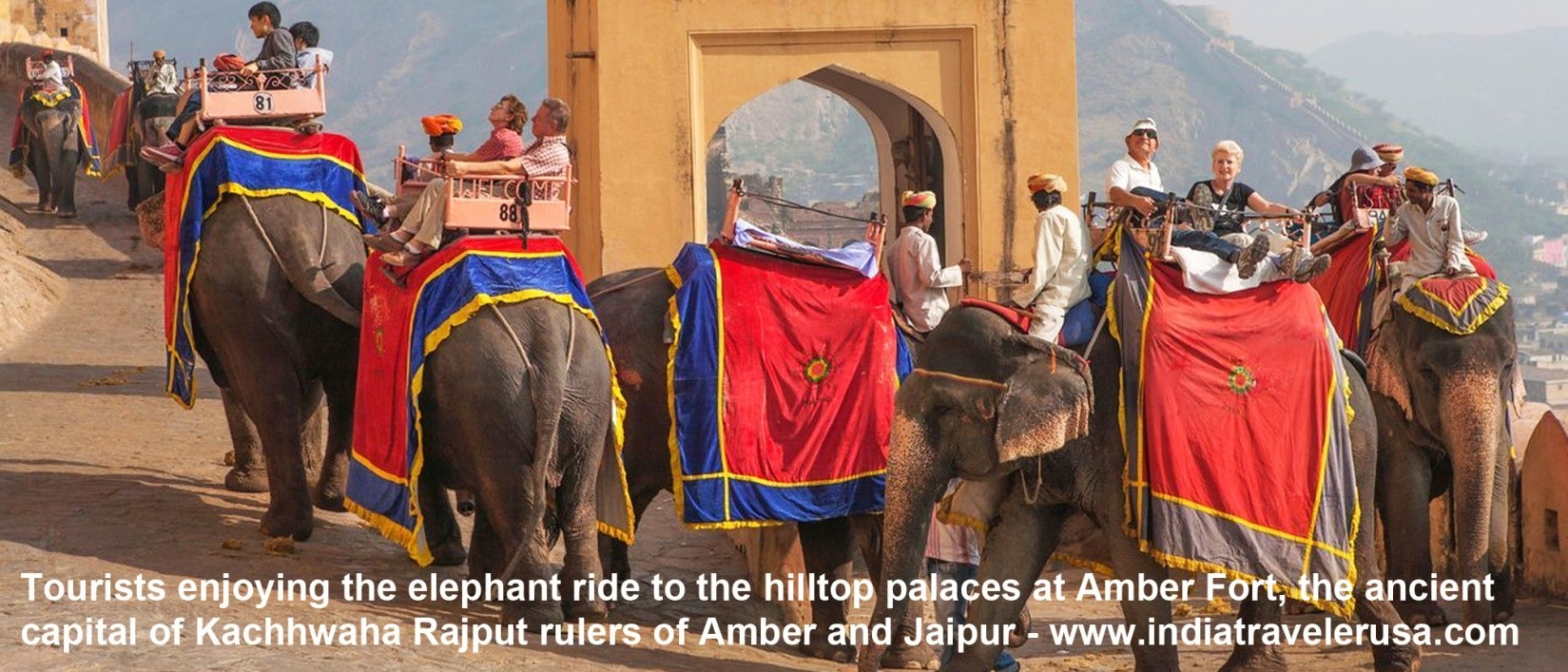
Drive further north through pink city to Amber Fort where you will enjoy a royal elephant ride to the hilltop palaces of Sawai Jai Singh, Mirza Raja Jai Singh and Maharaja Man Singh (one of nine jewels of Emperor Akbar’s cabinet of nobles). On the way back stop at the Jal Mahal Island Palace.
Jaipur City was designed by Maharaja Sawai Jai Singh and his principal architectural and city planning advisor, Vidhyadhar Bhattacharya.On July 6, 2019 the entire walled and painted pink city has been declared a UNESCO WORLD HERITAGE SITE.
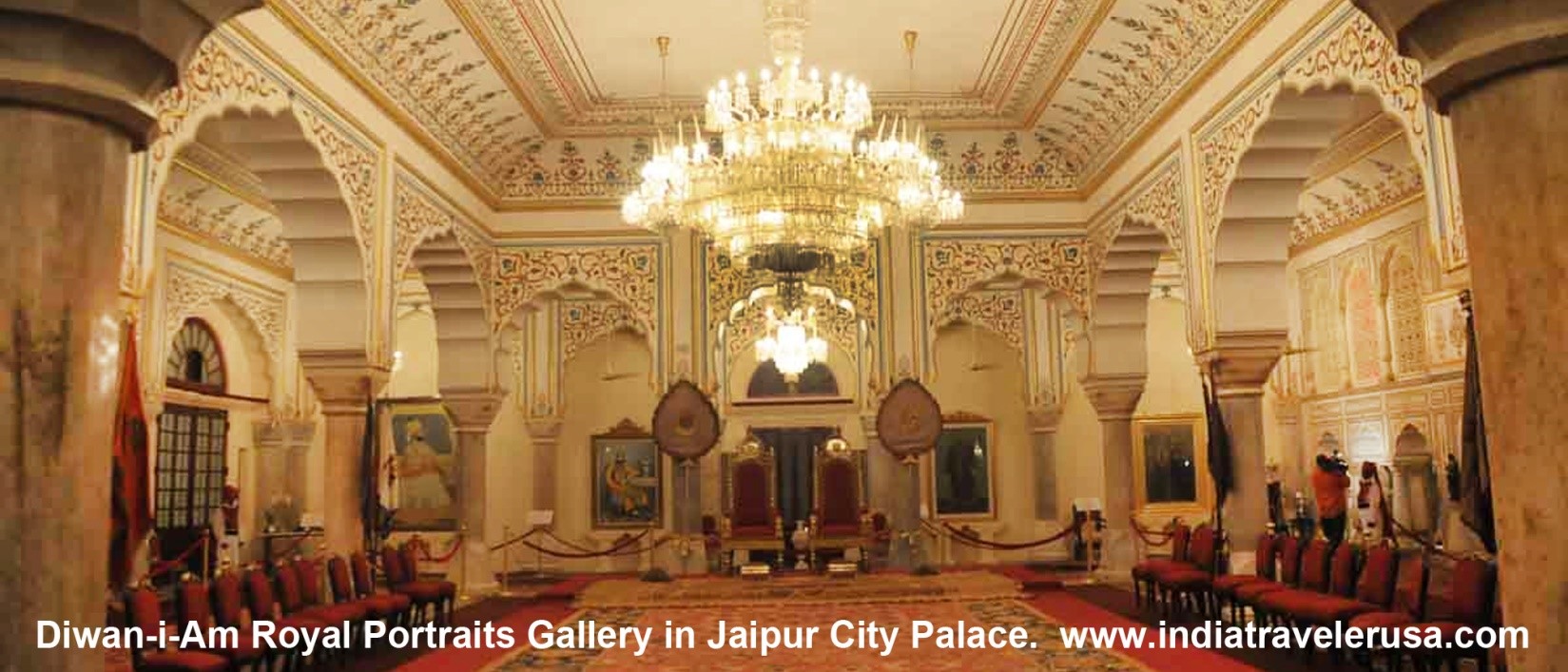
In the afternoon visit the City Palace including the Royal portraits gallery in the Diwan-i-Am (Hall of Public Audience), the Diwan-i-Khas (Hall of Private Audience), the Mor Chowk (peacock) courtyard of Chandra Mahal, the palace where the present head of the Jaipur royal still resides.
When he is in the building the family’s royal flag flies on its roof.

Later wonder at the 16 still functioning astronomical instruments of the Jantar Mantar observatory of Maharaja Sawai Jai Singh. The Brihat Samrat Yantra (large sundial) here has an accuracy of 2 seconds. This masonry astronomical observatory is the largest and best maintained of the five observatories constructed in Ujjain, Varanasi, New Dehi and Mathura. The observatory in Mathura was demolished in the colonial British East India Company period.
Overnight stay in hotel in Jaipur.
DAY 07: JAIPUR - DELHI (260 Kilometers or 162 miles in 5 hours) :
Morning is free to relax. After lunch drive to New Delhi.Farewell dinner and transfer to Indira Gandhi International Airport to board your flight back to USA.
| City | 3 or 4-Star Hotel | 5-Star Hotel | NO. OVERNIGHTS |
|---|---|---|---|
| NEW DELHI | Hotel Palace Heights, Conn. Place | The Surya Hotel | 2 |
| AGRA | Taj Resorts, east gate Taj Mahal | Double Tree Hilton | 2 |
| JAPIUR | Royal Orchid Central Hotel | Radisson Center City Hotel | 2 |
| NEW DELHI | Atrio Boutique Hotel | Novotel / Pullman Aerocity | Dinner |
Please call or email us to choose the above mentioned or other hotels. We will inform you of the best price at the time. In the inclusions section below remove the validity dates.
THE ABOVE PRICES INCLUDE :
- • 06 overnights - accommodations in the mentioned or similar hotels inclusive of taxes on double or twin room occupancy basis
- • Daily buffet breakfast at your hotels.
- • Chauffeur driven air-conditioned Toyota Itios or similar car for up to 2 persons or Toyota Innova Van or similar vehicle for 4 persons as per the program.
- • Daily bottled water in car
- • English speaking local guides as per program in New Delhi and Jaipur, in Agra only at Itmad-ud - Daulah
- • Assistance at each city by our company representative.
- • 1 rickshaw ride at Jama Mosque in Delhi.
- • 1 Elephant ride at Amber Fort in Jaipur.
- • Farewell dinner in Delhi
- • All taxes, parking fees, interstate taxes, state taxes, driver’s allowance etc.
- • Valid up to 31 March 2020 and from 1 October 2020 to 31 March 2021 (except between 20 Dec 2020 till 06 Jan 2021).
CASH & CREDIT CARDS:
Cash transactions can generally be made in either U.S. dollars or local currency. U.S. dollars should be recently issued bills in smaller denominations. The import and export of Indian Rupees is strictly prohibited unless you are a resident of India. So make certain to conduct any currency exchanges within India. Major credit cards are accepted on a limited basis, mainly in the larger shops, hotels and restaurants. Access to ATM machines is widespread in cities and towns but limited in rural areas.
NOT INCLUDED IN ABOVE PRICES :
Cost of international airfare, we will be glad to get you the best airfares through our international flight consolidator
US citizens require their passports to be valid for six months after return date from India i.e. July 14, 2020. Visa for travel to India can be applied online at: https://indianvisaonline.gov.in/evisa/Registration
All travelers, regardless of age, must present an original COVID-19 vaccination certificate indicating full vaccination completed at least 15 days prior to arrival. The current approved vaccines are Pfizer (Comirnaty), Moderna (Spikevax) and AstraZeneca (Vaxzevria) and Janssen/Johnson & Johnson (Ad26.COV2.S). To meet changing requirements, a booster shot is recommended.
In accordance with local regulations, face masks must be worn in public areas, including hotels and outdoor spaces where physical distancing of at least 6 feet (2 meters) cannot be maintained. We encourage you to bring your own masks; a supply will be on hand where needed. Note all protocols are subject to change in accordance with relevant guidelines, local regulations and conditions.
- • Cost of Travel Insurance
- • Cost of lunches and dinners
- • All drinks in hotels & restaurants etc.
- • Still and Video Camera Fees at monuments
- • Tips to drivers, guides and porters as well as any item not included in the above (included) list
- • All expenses of personal nature like telephone calls / laundry / room service charges in hotels etc.
PAYMENT :
An advance payment of US $500 is required to be paid with reservation. We will send you the reservation form. The balance amount is due 90 days before the departure date from USA. Payments can be made by personal check in favor of INDIA TRAVELLER or by PAYPAL.
PLEASE NOTE:All monuments in Jaipur close at 4.30 PM.
Red Fort in Delhi is closed on Mondays.
Taj Mahal in Agra is closed on Fridays.
OPTIONAL EXCURSION TOURS (Please call for details and price) :
FROM NEW DELHI :
.jpg)
Nepal Culture Tour- 4 Nights beginning from New Delhi by flight to Kathmandu, sightseeing of Kathmandu Valley including Bhaktapur and Patan, an overnight excursion to Nagarkot Himalayan Mountain Resort and ending with an awesom Mount Everest Flight. Read More
An extra overnight in Delhi to visit one or more of the three important museums of Delhi:
- 1. National Museum of artifacts from Indian and foreign antiquity and archaeological excavations, ancient coins, miniature paintings, manuscripts, Buddhist artifacts including the holy relics of Buddha from Kapilvastu where he spent his childhood and youth and/or
- 2. National Gallery of Modern Art in the former palace of the Maharaja of Jaipur near India Gate and / or
- 3. Craft Museum where you can witness fine traditional crafts in folk painting, textiles, terracotta figurines and pottery, wood carvings etc. and / or
- 4. visit the Akshardham Swami Narayan Temple - capital's largest Hindu temple (about 3 hours required for temple sightseeing).
- 5. Rishikesh: Is famous for its Yoga Ashrams where we can arrange admission to a Yoga Course. The city is also a haven for white water river rafting, bungy jumping and giant swing bungy jumping.
FROM AGRA :
- 1. Sur Sarovar Bird Sanctuary with Bear Rescue Center that has 256 black Himalayan bears and the Elephant Sanctuary (both these are inside the bird sanctuary) and / or
- 2. visit the Archaeological Museum at Mathura that has India's largest collections of Kushan, Gandhar and Gupta period sculptures and /or
- 3. Krishna Janmabhumi - the birthplace of Bhagwan Krishna, the incarnation of Vishnu and / or the ISCKON. Hare Krishna Temple in Vrindavan.
- 4. Datia Fort / Palace – This amazing fort is rarely visited by tourists. It is located 207 kilometers or 129 miles from Agra and about 75 kilometers or 47 miles from Gwalior. It was built by the Jat Bundela ruler, Raja Bir Singh Deo in 1614. It was one of the ancient heritage sites that Sir Edwin Lutyens, the architect appointed by British East India Company, visited and was so influenced that he incorporated many of its elements in the Viceroy’s Palace (now Rashtrapati Bhawan).
- 5. Gwalior - with one overnight in the luxurious Taj Usha Kiran Palace or Neemrana Deo Bagh Heritage Hotel or in one of its many good 3-star hotels, one can have a full day of sightseeing of Gwalior Fort and Scindia Maharaja's Jai Vilas Palace.
- 6. Keoladeo Ghana Bird Sanctuary in Bharatpur where about 150 Indian species of birds reside throughout the year and another 150 species of migratory birds arrive from Tibet, China, Mongolia, Siberia and even Scandinavia. This requires one overnight in Bharatpur. The best hotel in Bharatpur is the Laxmi Vilas Palace Hotel.


FROM JAIPUR :
- 1. Chand Baori : About an hour before arriving in Jaipur is the town of Dausa that is quite close to Chand Baori - the world's deepest stepwell and the Hindu temple of goddess Harshat Mata, there is a large collection of sculptures found in the vicinity here.
- 2. Sisodia Rani Garden Palace : Just before entering Jaipur in the valley of Aravali Mountains is the Garden Palace of Sisodia Rani (Queen of Sawai Jai Singh belonging to the royal house of Mewar in Udaipur)
- 3. Galta Natural Spring and Hindu Pilgrimage Center : further in the same valley is the Hindu pilgrimage center of Galta with a natural water spring and many beautiful Temples.
- 4. Samode Palace : A luxurious palace famous for its glass mosaic audience hall is located in a quiet valley and is surrounded by a small village. A walk in the village is interesting to observe rural life in this region. In winter months children are playing Cricket and it may be possible to join in their game.
- 5. Nawalgarh : About an hour and a half drive from Samode (94 kilometers) on the way to Mandawa enjoy the sightseeing of the murals and frescos of Anandilal Poddar Haveli and Murarka Haveli. If one wishes to stay overnight there are three heritage hotels: Roop Vilas Palace Hotel or Roop Niwas Kothi or Vivaana Heritage Hotel.
- 6. Mandawa : There is a lot to view in the Mandawa Castle itself that is also the best place to stay in Shekhavati region. Following Haveli (aristocratic mansions) are interesting for their murals and frescos: Hanuman Prasad Goenka Haveli, Goenka Double Haveli, Murmuria Haveli, Jhunjhunwala Haveli, Mohanlal Saraf Havei, Gulab Rai Ladia Haveli, Bansidhar Newatia Haveli, Laxminarayan Ladia Haveli and Chowkhani Double Haveli. Just across the road from Goenka Double Haveli is the Thakurji Temple that also has beautiful mural paintings depicting scenes from British East India Company Period and 1857 during the First War of Indian Independence.


